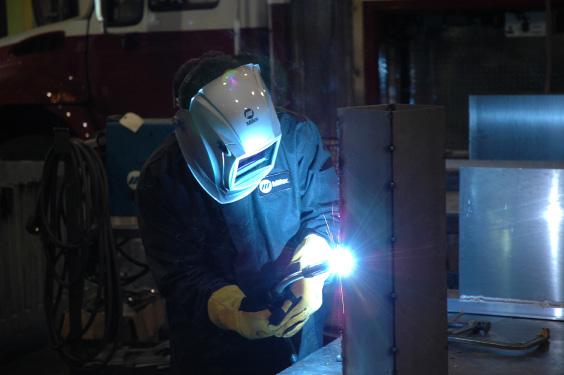
3 minute read
When to Consider a Move to Pulsed MIG Welding
By Kodi Welch, welding engineer/CWI, Miller Electric Mfg. LLC
From reduced spatter and rework to increased weld quality and productivity, the benefits of a switch to pulsed MIG welding can help manufacturing operations reach their productivity goals and save money.
Because of the numerous benefits of the process, many industries are converting to pulsed MIG. So how do companies know when

Pulsed MIG is a modified spray transfer process that allows operators to run faster wire speeds while keeping a clean arc and bead profile, which helps reduce spatter and cleanup. to make the switch? Read more about six questions that can help manufacturers determine if it’s a good fit that will deliver results for their welding operation.
The pulsed MIG process
Pulsed MIG is a modified spray transfer process. The welding power source rapidly switches the welding output between high peak currents and low background current. The peak current pinches off a spray-transfer droplet and propels it toward the weldment, which helps create proper fusion. The background current maintains the arc, but it is too low for metal transfer to occur.
Because the weld pool cools slightly during the background cycle, it allows for welding in all positions, on thin or thick metals. It also allows operators to run faster wire speeds while keeping a clean arc and bead profile, which reduces spatter and cleanup.
Making the move to pulsed MIG
Pulsed MIG delivers benefits that result in time and cost savings in the right applications. Operations that are now using CV MIG with solid wire or metal-cored wire are good candidates for conversion to pulsed MIG. When considering the switch, think about these six common issues in the welding operation.
Do post-weld grinding and cleanup cost too much time and money?
If an operation wants to save time and money by reducing nonvalue-added work, such as post-weld grinding and cleaning, pulsed MIG can deliver. With pulsing, operators can use the entire wire speed range without entering globular transfer. This is a benefit for material thicknesses where conventional CV MIG would transition to a globular transfer, which results in extreme spatter, poor arc characteristics and the potential for rework. With pulsed MIG, operators can run globular transfer wire speeds and keep a clean arc and bead profile. This reduces spatter, plus the time and money spent on cleanup.
Is new welder training eating up a lot of time?
operators are using the right parameters for the job. Accu-Pulse™ technology from Miller, available on Deltaweld® system power sources, provides a more forgiving arc and a 28 percent wider operating window, which helps welders of many skill levels produce quality welds.
Is increased productivity a goal?
Compared to standard spray transfer, pulsed MIG welding typically delivers an increase in wire feed speed to match welding amperage. As a result, more weld metal goes into the joint, which can increase productivity. This is in addition to the other benefits of pulsed MIG—the ability to reduce spatter, distortion and burnthrough—that can also help operations improve throughput and productivity and spend less time on non-value-added activities.
Because pulsed MIG is generally an easy process to learn and use, it can help operations train new welders faster. Pulsed MIG systems are designed with synergic control that offers ease of use for welders of all skill levels. Easier process setup translates into time savings and better weld quality, since it helps ensure
Are distortion and burn-through problems part of your welding operation?
Problems with weld quality, such as distortion or burn-through, can waste materials and cost operations lots of money. This can be especially true with operations that weld a lot of aluminum,











